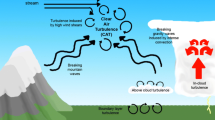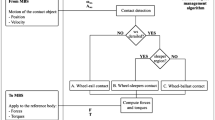Summary
Variations in rail temperature are responsible for a large proportion of weather related delays on the rail network. Tracks are pre-stressed to withstand a specified range of temperature, but once the range is breached the rail can distort causing tension cracks in cold weather and buckling in hot weather. Currently, blanket speed restrictions are imposed at certain temperature thresholds to ensure passenger safety. This paper discusses the measurement and modelling of rail temperature data at both a specially constructed test track and a ‘live’ main-line track. Although, empirical techniques are presently used to derive rail temperatures from air temperatures, this approach is limited as it fails to take into account other ambient weather conditions. To address this, a road weather model was converted to model the energy balance of a rail. This enables rail temperatures to be forecasted for the entire diurnal cycle and at a variety of synoptic conditions. The physical model shows significant forecasting ability, outperforming empirical techniques with a mean bias of 0.2 °C (RMSE = 2.56°) for a 200 day measurement campaign.
Similar content being viewed by others
References
J Bogren T Gustavsson S Lindqvist (1992) ArticleTitleA description of a local climatological model used to predict temperature variations along stretches of road Meteorol Mag 121 157–164
S Burt (2004) ArticleTitleThe August 2003 heatwave in the United Kingdom Weather 59 199–208 Occurrence Handle10.1256/wea.10.04A
L Chapman (2000) ArticleTitleAssessing topographic exposure Meteorol Appl 7 355–340 Occurrence Handle10.1017/S1350482700001729
L Chapman JE Thornes A Bradley (2001) ArticleTitleModelling of road surface temperature from a geographical database: Part 2: Numerical Meteorol Appl 8 421–436 Occurrence Handle10.1017/S1350482701004042
L Chapman JE Thornes (2006) ArticleTitleA geomatics based road surface temperature prediction model Sci Total Environ 360 68–80 Occurrence Handle10.1016/j.scitotenv.2005.08.025
L Chapman JE Thornes SP White (2006) ArticleTitleThermal imaging of railways to identify track sections prone to buckling. Proceedings of the Institution of Mechanical Engineers, Part F J Rail Rapid Transit 220 317–327 Occurrence Handle10.1243/09544097JRRT73
Eddowes MJ, Waller D, Taylor P, Briggs B, Meade T, Ferguson I (2003) Rail safety & standards board: safety implications of weather, climate and climate change. Issue 2, AEAT/RAIR/76148/R03/005, March 2003, 63 pp
Esveld C (2001) Modern railway track. MRT Publications, 2nd edn. 654 pp
Ewens G (1994) When the trains don’t come. New Scientist, 19th February, pp 38–40
T Gustavsson (1999) ArticleTitleThermal mapping – a technique for road climatological studies Meteorol Appl 6 385–394 Occurrence Handle10.1017/S1350482799001334
M Hamer (2003) ArticleTitleWatch out for bad vibes New Sci 178 IssueID2393 20–21
U Hoppmann S Koenig T Tielkes G Matschke (2002) ArticleTitleA short-term strong wind prediction model for railway application: design and verification J Wind Eng Ind Aerod 90 1127–1134 Occurrence Handle10.1016/S0167-6105(02)00226-X
Hunt GA (1994) An analysis of track buckling risk. British Railways Internal Report RRTM013, 31pp
T Imai T Fujii K Tanemoto T Shimamura T Maeda H Ishida Y Hibino (2002) ArticleTitleNew train regulation method based on wind direction and velocity of natural wind against strong winds J Wind Eng Ind Aerod 90 12–15 Occurrence Handle10.1016/S0167-6105(02)00273-8
T Noguchi T Fujii (2000) ArticleTitleMinimizing the effect of Natural Disasters Jpn Railway Transport Rev 23 52–59
TR Oke (1987) Boundary layer climates Methuen London
SI Outcalt (1971) ArticleTitleA numerical surface climate simulator Geogr Anal 3 379–393 Occurrence Handle10.1111/j.1538-4632.1971.tb00378.x
Rogers M (2002) Keeping rail moving – whatever the weather. Rail Management, Spring Issue, pp 76–77
J Shao PJ Lister (1996) ArticleTitleAn automated nowcasting model of road surface temperature and state for winter road maintenance J Appl Meteor 35 1352–1361 Occurrence Handle10.1175/1520-0450(1996)035<1352:AANMOR>2.0.CO;2
J Shao SJ Laux BJ Trainor REW Pettifer (2003) ArticleTitleNowcasts of temperature and ice on overhead railway transmission wires Meteorol Appl 10 122–133 Occurrence Handle10.1017/S1350482703002044
Smith K (1990) Weather sensitivity of rail transport. Proc. of the Technical Conference, WMO-No. 733, Geneva, pp 236–244
Thornes JE (1984) The prediction of ice formation on motorways in Britain. Unpublished PhD Thesis, Department of Geography, University of London, UK
JE Thornes (1997a) Impact on transport, ch. 11 Palutikof (Eds) et al. Economic impacts of the hot summer and unusually warm year of 1995 Dept. of Transport London 129–138
JE Thornes (1997b) Transport systems, ch.15 RD Thompson AH Perry (Eds) Applied climatology Routledge London 198–214
Thornes JE, Davis B (2002) Managing the effects of weather on the rail network. Proc. of the 5th Rail Engineering Conference, London
Ventry D (2002) Railtrack company specification: continuous welded rail (CWR) track. RT/CE/S/011, Issue 4, February 2002, 55 pp
Author information
Authors and Affiliations
Additional information
Authors’ address: L. Chapman, J. E. Thornes, Y. Huang, X. Cai, V. L. Sanderson, S. P. White, Entice Technology Ltd, School of Geography, Earth and Environmental Sciences, University of Birmingham, Birmingham B15 2TT, U.K.
Rights and permissions
About this article
Cite this article
Chapman, L., Thornes, J., Huang, Y. et al. Modelling of rail surface temperatures: a preliminary study. Theor Appl Climatol 92, 121–131 (2008). https://doi.org/10.1007/s00704-007-0313-5
Received:
Revised:
Accepted:
Published:
Issue Date:
DOI: https://doi.org/10.1007/s00704-007-0313-5




